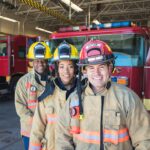Firefighter Health and Wellness
By Edward J. Power, A.S., B.S., MPA | | 4 Min Read
Communities make large, expensive investments in their fire departments apparatus, equipment, and training just to name a few. What is a community’s biggest, most precious investment? Firefighters.
Organizations spend a lot of time and money researching and appropriating funds for our fire departments. Depending on the level of management and funding support, departments have life spans of from as small as ten years to that of the Boston Fire Department which has continuously (formally) operated since 18371. Many of the tools and equipment needed by these departments to operate effectively over their life spans are required by various government and industry standards to be inspected, tested or recertified on an annual basis. If we take this approach to the tools and equipment we use, shouldn’t we take this same approach to our most valuable department assets, our firefighters? Shouldn’t management and labor be working in a collaborative effort to ensure firefighters have the longest, healthiest life span possible?
The Current Landscape of Firefighter Health and Wellness
Most fire departments require medical exams, physical ability tests and psychological exams prior to being hired by a municipality, yet according to a needs assessment study completed by the National Fire Protection Association (NFPA)2:
Barring illness or injury, fire departments rarely require or offer any type of continuing evaluation of a firefighter’s health due to numerous challenges as labor and management try to find an agreeable balance with collective bargaining agreements and public funding. The International Association of Fire Fighters (IAFF), the International Association of Fire Chiefs (IAFC), the United States Fire Administration (USFA) and other organizations agree that investments in firefighter health and wellness programs reap many benefits. According to numerous studies from these groups, it is estimated that for every dollar invested in a Firefighter Health and Wellness Program, there is a two to three dollar return on investment3.
The Importance of Establishing a Firefighter Diet and Exercise Program
By establishing a Firefighter Health and Wellness program we can have early identification of various medical issues such as cardiovascular problems, respiratory issues, cancer and communicable diseases among others. We can also establish diet and exercise programs to help:
- Reduce or eliminate developing medical issues
- Reduce or eliminate orthopedic or structural injuries such as breaks, strains and sprains
- Gain a financial benefit to these preventative programs by avoiding unnecessary costs associated with medical attention
- Proactively address long term emotional impacts from traumatic events common in the firefighting role
Emotional Well-Being
Think of the emotional, moral and financial costs associated with death, injury or illness. Both personal and professional emotional costs exist to the firefighter as there will be time away from the job, a disconnect from comrades and the potential for reduced moral. God forbid there is a death – the costs on all levels are incalculable.
When planning and reviewing cost planning for emotional well-being, departments should consider questions like:
- How much be spent to address the firefighter’s needs through surgery, physical therapy, rehabilitation and prescription drugs?
- Are the shifts being covered by other firefighters through unanticipated overtime?
- Can the firefighter return to work or will he or she be forced to retire via a disability pension?
Impacts of Our Decisions
Each decision we make, each action or inaction has an impact. These decisions will not only impact the firefighter themselves, but their company, department, community and most importantly their family. All of us in the fire service should be keenly aware of the statistics related to firefighter mortality and injury/disability rates from cancer, cardiac death, communicable diseases, injuries and emotional stress such as post-traumatic stress disorder (PTSD).4
The job of a firefighter is inherently dangerous, however, we owe it to ourselves and our families to take proactive steps to reduce or eliminate these risks.
Making the Move to Protect Our Firefighters
How can we accomplish this? By engaging in a Firefighter Health and Wellness program, regardless if it is a formal program within your organization or a personal one you developed on your own. Eat healthy and exercise regularly, wear your Personal Protective Equipment (PPE) including your Self-Contained Breathing Apparatus (SCBA), wash your PPE on a regular basis and after each fire or exposure, seek out counseling or debriefing after the tough calls, and get an annual physical. Some helpful resources that can be references while developing a health and wellness plan for your department include:
- Assistance to Firefighters Grant Program
- Starting a Firefighter Health and Wellness Program Guide from NVFC
- IAFF Wellness Fitness Initiative Resource
- Firefighter Health and Wellness
Stay safe!
Sources
- BOSTON HISTORY BEFORE 1859. Boston Fire Historical Society. (2015). Retrieved July 9, 2015. https://bostonfirehistory.org/boston-history-before-1859/.
- A Third Needs Assessment of the U.S. Fire Service. National Fire Protection Association (NFPA) (2011). Accessed July 9, 2015. https://www.nfpa.org/education-and-research/research/nfpa-research/fire-statistical-reports/needs-assessment?l=65.
- Wellness Fitness Initiative – Cost Justification. (2015 Accessed July 9, 2015. https://www.iaff.org/.
- https://www.nimh.nih.gov/health/topics/post-traumatic-stress-disorder-ptsd.

Author Bio: Edward J. Power, A.S., B.S., MPA
Edward Power has been an instructor with AMC’s fire science and public administration programs since 2012 and is currently a Lieutenant with the Lynn MA Fire Department. Prior to joining the Lynn Fire Department, Ed was the Supervisor of the Needham MA Fire Department’s Communications Division.
Ed is also an Instructor with the Massachusetts Firefighting Academy where he teaches in several programs, including the Recruit Firefighter, Fire Officer and Rapid Intervention Programs. Ed holds both a Master of Public Administration and a Bachelor of Fire Science Administration degree from Anna Maria College as well as an A.S. in Fire Science Technology from North Shore Community College.
He also holds several certifications relative to the fire service including: Fire Instructor 1, Fire Officer 1, Safety Officer 1 and Emergency Medical Technician. Throughout his career, Ed has attained almost 20 years’ experience in the emergency services field.

